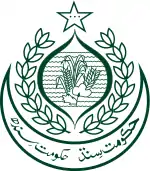Moinuddin Haider
Moinuddin Haider, HI(M) (Urdu: معین الدین حیدر ; born 5 June 1942) is a retired lieutenant general of the Pakistan Army, who after retirement served as the Governor of Sindh and then as the Interior Minister of Pakistan.
Moinuddin Haider معین الدین حیدر | |
|---|---|
| 30th Minister of Interior | |
| In office 6 November 1999 – 23 November 2002 | |
| President | General Pervez Musharraf |
| Preceded by | Shujaat Hussain |
| Succeeded by | Faisal Saleh Hayat |
| Governor of Sindh | |
| In office 17 March 1997 – 17 June 1999 | |
| President | Rafiq Tarar |
| Prime Minister | Nawaz Sharif |
| Preceded by | Kamaluddin Azfar |
| Succeeded by | Mamnoon Hussain |
| Personal details | |
| Born | 5 June 1942 Delhi, British India |
| Nationality | |
| Children | Captain Noman Uddin Haider Asma Haider |
| Residence | Karachi,Pakistan |
| Alma mater | PAF Public School Lower Topa Royal College of Defence Studies |
| Committees | Chairman Fatimid Foundation,Member Pildat |
| Awards | Hilal-i-Imtiaz (Military) |
| Military service | |
| Allegiance | |
| Branch/service | |
| Years of service | 1962–1997 |
| Rank | Lieutenant-General |
| Unit | F.F. Regiment |
| Commands | 33rd Infantry Division, Quetta Deputy Chief of General Staff (DCGS) Adjutant General (AG) IV Corps |
| Battles/wars | Indo-Pakistani War of 1965 Indo-Pakistani War of 1971 |
Army career
Haider was commissioned in the Pakistan Army in 1962 first in the 26th PMA Long Course in the Frontier Force Regiment. He did his master's degree in defence studies from Royal College of Defence Studies, Seaford House, UK, and has the distinction of being the first Pakistani to get his thesis published in Seaford House Papers.
He saw action in the 1965 and the 1971 Indo-Pak wars. He served as instructor at PMA from 1967 to 1970. He commanded a reconnaissance and support battalion twice in 1975–77 and in 1981–82. Later he was head of Pakistan Mutual Cooperation Group in Somalia from 1978 to 1981. Subsequently, he served as GSO-I operations and colonel staff in an infantry division.
Senior command and staff appointments
Promoted to brigadier in 1983, he left for the UK to attend Royal College of Defence Studies course in 1984 and was the first Pakistani officer whose thesis was published in Seaford House papers. He was appointed director military training at GHQ in 1986 and was closely associated with planning of Zarb-e-Momin.
As a two-star, Haider commanded the 33rd Infantry Division at Quetta from 1989 to 1991. He then stayed as the Deputy Chief of General Staff (DCGS) at the GHQ from 1991 to 1993. After becoming a three-star general, he first served as the adjutant general (AG) from 1993 to 1996, and then as the Corps Commander Lahore from 1996 to 1997.
Government service
After retirement in March 1997, he was installed as the governor of Sindh province by the Nawaz Sharif government. He continued to serve as the governor till June 1999 when he was replaced by Mamnoon Hussain. At the onset of military coup in October 1999, General Pervez Musharraf, a junior to Haider as he belonged to 29th PMA Long Course, put Haider as the Interior Minister of Pakistan. He continued to lead the powerful ministry till the 2002 October elections, when Faisal Saleh Hayat replaced him. During his time as Interior Minister he was very involved in hunting down and bringing to justice the killers of American Wall Street Journal reporter Daniel Pearl.
Moinuddin Haider is the graduate of PAF Public School Lower Topa and is the current patron in chief of the Lower Topa Old Boys Association (LOBA).[1] He is married and has three children.
References
- "Old Topians reunite" Daily Times, 28 July 20
External links
- Biography of Moinuddin Haider
- Profile at National Police Bureau
- Interview of Lt Gen (retd) Moinuddin Haider
| Political offices | ||
|---|---|---|
| Preceded by Kamaluddin Azfar |
Governor of Sindh 1997–1999 |
Succeeded by Mamnoon Hussain |
| Preceded by Chaudhry Shujaat Hussain |
Interior Minister of Pakistan 1999–2002 |
Succeeded by Faisal Saleh Hayat |


